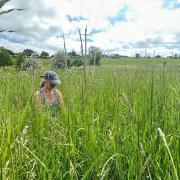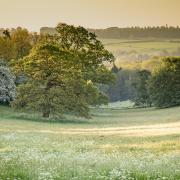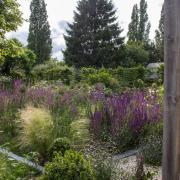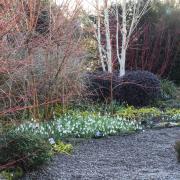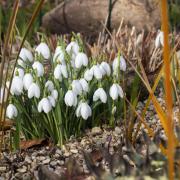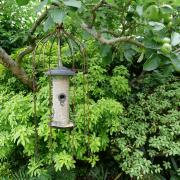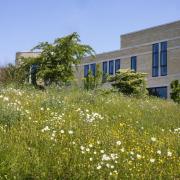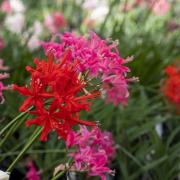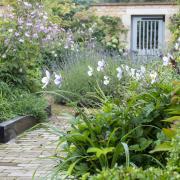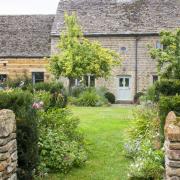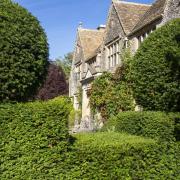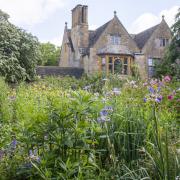The gardens at Thyme combine the old with the new in style. Words and pictures by Mandy Bradshaw
Sweetly scented roses, clouds of nepeta and clipped yew, at first glance the Ox Barn Yard garden at Thyme appears typical of so many in the Cotswolds. Yet closer examination reveals something far more interesting.
Indeed, avoiding the purely traditional was the aim of designer Bunny Guinness when she first started on the garden in Southrop around 15 years ago, echoing the work of architects who have given a modern facelift to the old buildings, which now house a boutique hotel, cookery school, shop and spa.
‘We’ve tried to do the same with the landscape,’ she says. ‘We’ve used mainly traditional materials but tried to give a bit of a modern feel to it.’
The result is somewhere that, while sympathetic to Thyme’s buildings, is not stuck in the past.

Seating is not the wood so often seen in Cotswold gardens but acid-etched metal in soft grey that wraps around hawthorn trees or mingles with billowing flowers.
‘It has a swirly style, which I really like. It is sort of traditional but somehow doesn’t feel totally traditional.
‘It bounces light off if it’s a wet day,’ adds Bunny. ‘It doesn’t look drab like timber does.’

Elsewhere, paving is broken up by gravel that’s been softened with planting – Erigeron karvinskianus, lavender, Euphorbia myrsinites – giving the sense of a garden that is managed with a light touch.
‘I wanted to give it a slightly wilder feel and hopefully not scruffy.’
In contrast, the main flower beds are planted in strips to give the impression of a productive garden.
‘I wanted to keep that feel rather than just normal flower beds.’
When work started on this area there was little beyond a lot of concrete that sloped away to one side.
‘It felt a bit like a farmyard at that point,’ recalls Bunny, who has won six gold medals for her designs at RHS shows, including Chelsea.

She introduced a strong framework based on four quadrants – ‘I do like strong patterns in my designs.’ – with these areas further broken down into quite complex spaces of planting, hornbeam arches and metal octagon arbours, and the more loosely planted areas of gravel.
At the centre are sett-edged, raised square lawns and a circular raised pool – ‘I think that’s just a clear breathing space with not a lot going on.’
The same setts are used around cork oaks that add height to this central area. Meanwhile, using pleached trees – a more unusual choice of pears – helps to create intimate areas for Thyme’s guests to enjoy.
‘I'm often working with large buildings and I think that if you're sitting beside a large building you can feel very exposed. That's why I like to break them down, and then have clear spaces as well as more intricate spaces.’

Courtyard bedrooms along one side of this area are given their own privacy with a buffer zone of hedges and trees.
More prosaic considerations had to be worked into the design for the garden outside the cookery school – where to site the bins, for example.
Raised beds are full of herbs, mature olive trees add a Mediterranean air, and there’s a long pergola over an outdoor dining table. Again, gravel is softened by planting, this time rosemary, fennel and thyme.

While the overall design is one based on rectangles, it’s given a pleasing contrast with serpentine lines of clipped box that run through the space.
This was the first area Bunny worked on with Thyme’s founder Caryn Hibbert. As the business has expanded, so have the gardens with Bunny keen to give each its own style.
‘I didn’t want them all to look the same. They are all distinct.’

As such, each has its own planting scheme although some things, such as yew hedges, are found throughout the gardens.
Topiary ensures the spaces look good in winter and Bunny has chosen plants that she feels perform over a long time. These include Nepeta grandiflora ‘Summer Magic’ – ‘It’s the earliest flower, it goes on the longest and it tends not to flop.’ – and roses ‘James L Austin’ and ‘Sally Holmes’, used because they flower for weeks.
One of the newest gardens is around the spa. This is a smaller, more intimate walled area set against cottage-like buildings with windows and doors painted in the green so often found in Cotswold villages.


Privacy for the treatment rooms was the key consideration here with chequer board beds of gravel and planting, including lavender, phlomis, artemisia and iris, coming out from each of the windows.
‘You wouldn’t walk on it,’ explains Bunny. ‘It just keeps you away from the windows.’
Topiarised yew adds year-round structure and there are seats for enjoying the tranquillity of this secluded spot. Meanwhile, multi-stemmed osmanthus contribute height.
Topiary has also been used to create privacy between private terraces for rooms in the Lodge. These areas have trees in baseless pots – one of Bunny’s trademark design tricks and something that’s found throughout Thyme.
Growing trees in pots – she gets many of them specially made – allows them to root into the ground, making them healthier: ‘I always think when you have plants in a pot long term they look sickly after a bit.’

Yet, this method, which she outlines on her YouTube account, means you can still retain the advantages of using pots: ‘If you get a big pot and put a plant in, you can get the foliage at eye level and that has a big psychological effect. It can really soften an ugly façade; it brings the scale down.’
In complete contrast to the designed spaces around Thyme’s buildings, the ancient water meadows on the outer edge of the site are largely untouched.

The section nearest the house has never been ploughed and this, along with another slightly wilder part, is now being carefully managed to encourage wildflowers and wildlife. Already the number of butterflies and birds has increased.
It’s something that Caryn is delighted to see: ‘Since we’re not doing very much down there, the insects, the butterflies, the wildlife, everything has really blossomed.’
It’s another layer that makes this garden far more than the average Cotswold space.
More information about Thyme is on the website: thyme.co.uk

Twitter: @ChattyGardener
Facebook: The Chatty Gardener
Instagram: @thechattygardener





